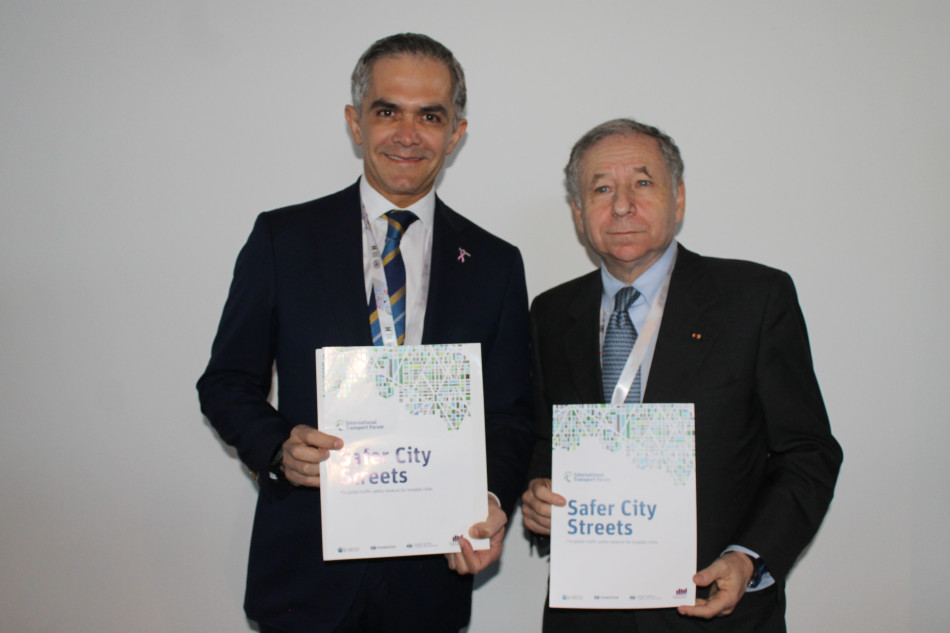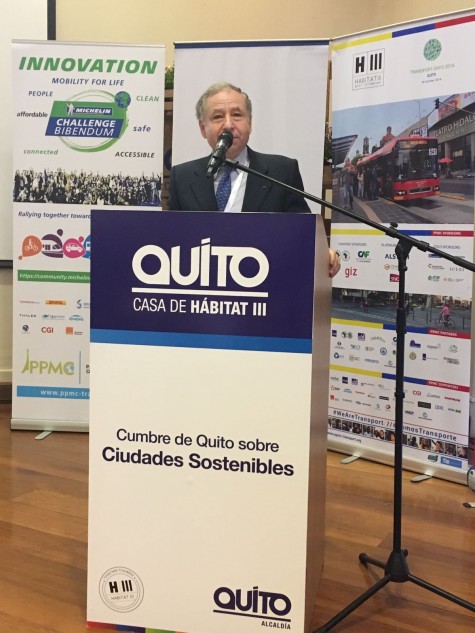Safer City Streets: A new network for cities that want to improve urban road safety
ITF and FIA team up for liveable cities by launching Safer City Streets at UN Habitat III in Quito

Safer City Streets, the new global traffic safety network for liveable cities, was launched during the UN Habitat III conference in Quito, Ecuador in presence of Jean Todt, FIA President and Miguel Ángel Mancera, Mayor of Mexico City.
Road safety is a growing issue for mayors and city managers. Rapid motorisation and urban population growth converge to create a deadly and costly dynamic:
- One person dies in urban traffic every minute
- Eight out of ten victims killed are pedestrians, cyclists and riders of powered two-wheelers
- Road deaths and injuries cost around 3% of GDP
Crashes on urban roads resulting in death and injuries cause immense human suffering. They also nurture a feeling of insecurity – and where streets are seen as dangerous, promoting walking and cycling becomes an uphill struggle.
Reducing the risks of urban traffic thus not only saves lives. It also encourages sustainable forms of mobility, helping to reduce pollution, cut emissions, fight congestion and make citizens healthier. In short: Safer streets make a city more liveable.
Cities address many challenges by working together and learning from each other – but so far not in the field of road safety data. Safer City Streets now fills this gap by linking cities that are working on making their citizens safer in traffic by improving the empirical evidence for policy decisions.
Cities provide data to the Safer City Streets database via a questionnaire and in return have free access to data from peer cities, thus allowing comparisons. The ITF manages the data collection and validation, analyses the data and administrates the network. Safer City Streets will go beyond the database by establishing a network of experts, whose goal is to exchange knowledge and learn from each other and their respective cities.
Safer City Streets builds on a 2013 pilot project with nine cities from Europe and North America that shared data on crashes, population, mobility and traffic. The success of the pilot gave birth to the idea of linking up cities worldwide for better road safety. Safer City Streets is modeled on ITF’s global road safety network of countries (known as the IRTAD Group), that has thrived for more than 25 years and which conducted the pilot.
Participation in Safer City Streets is free in 2016 and 2017 thanks to the FIA Road Safety Grant Programme, supported by the FIA Foundation.
“Safer City Streets provides city officials high-value information for better decision making”, explains ITF Secretary-General José Viegas. “Member cities have access to policy-relevant data, a network of experts and targeted analysis. It provides global networking and learning opportunities for city officials and the possibility to carry out research on topics of common interest.”
Jean Todt, President of the Fédération Internationale de l’Automobile (FIA) and UN Secretary General’s Special Envoy for Road Safety, said: “There is no urban agenda without safe and sustainable mobility. Improving road safety in cities is central to advancing the post-2015 development agenda. Cities should scale up efforts to transform urban mobility, making it safe and accessible for a growing number of city dwellers. It is my hope that the Safer City Streets will serve as a global platform for sharing best practices in urban policy making.”
Today, Jean Todt announced the initiative to the public during the Plenary 1 on "Sustainable Urban Transport and its Contribution towards Promoting Equitable and Inclusive Urban Development" of the Transport Day Quito in the framework of the UN Habitat III Conference.

More about Safer City Streets at: www.itf-oecd.org/safer-city-streets

 Facebook
Facebook Twitter
Twitter






